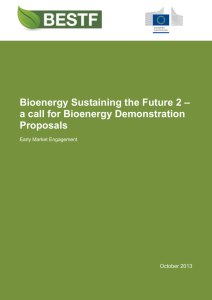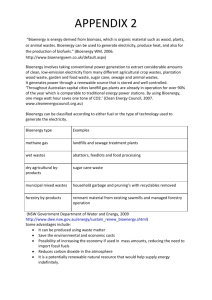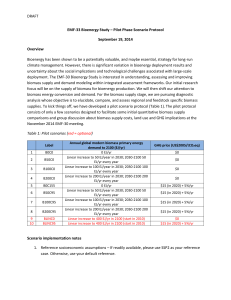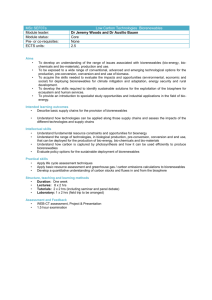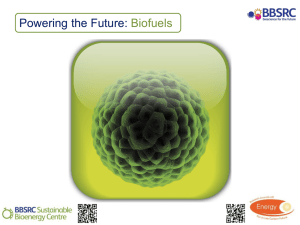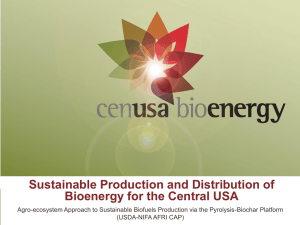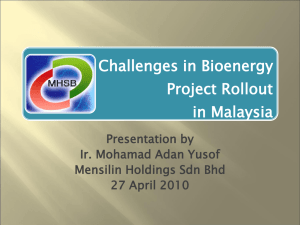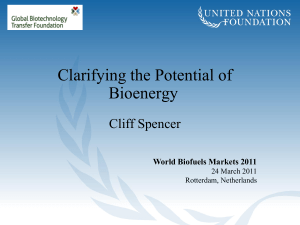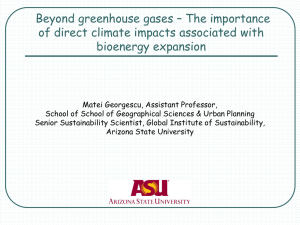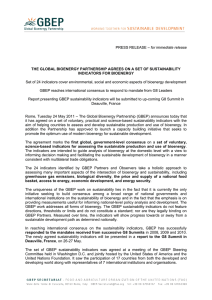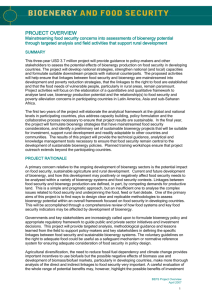Workshop Outcomes and Action Plans
advertisement
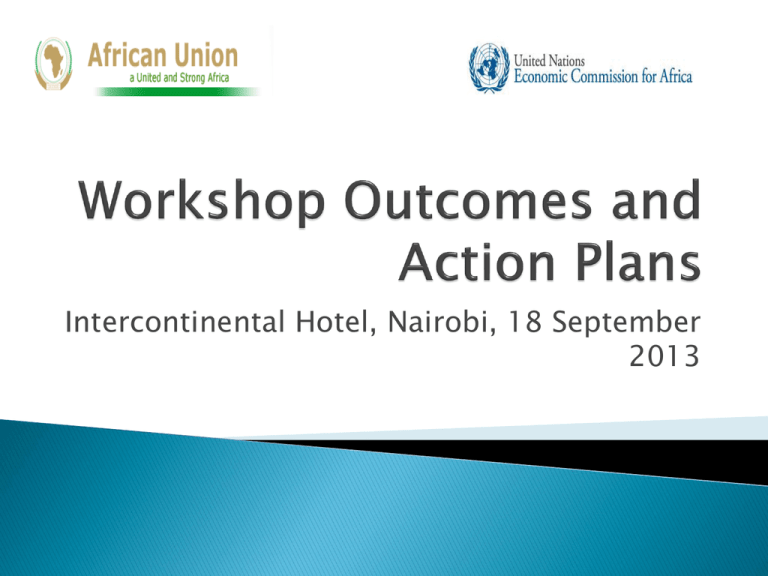
Intercontinental Hotel, Nairobi, 18 September 2013 Institutional cooperation must happen RECs and countries to develop a knowledge sharing mechanisms for lessons learned Address lack of statistical data – a barrier to planning Design of BETs involving end users, encourage ownership and uptake of technologies Policies should be made with full involvement of intended beneficiaries Strategies for forest management – ownership to communities Africa needs to move up from strenuous wood harvesting and use to more modern practices All 1st Gen techs available – no need to re-invent the wheel With modular technologies available for bioethanol & biodiesel, initial investment outlay can be small & can grow with feedstock availability Feedstock with low inputs to be promoted to increase participation in bioenergy industry R&D to on efficient BETs, sustainable harvesting of forestry, feedstock with low inputs, efficient feedstock mgmnt & markets for bioenergy products and co-products Build capacity for governments, industry, consumers, universities/education institutions, Tool NOT prescriptive but enables countries to make better and informed choices about policy directions Tool for managing risks and benefits Production cost varies from feedstock, business model etc., but some more expensive options may lead to desirable co-benefits – up to the country to make choice as to the best models depending on its developmental objectives Energy insecurity causes Food insecurity – Complex Interaction btn Energy and Food Training for using the BEFS tool in countries Gender equity as part of the policy objectives in bioenergy development – in bioenergy in strategy and policy development, implementation, and monitoring Apply a gender lens to bioenergy development (or in the value Involve end users in design of technologies Education and Training – change behavioral patterns, skill development, etc. Special Support Schemes (finance, capacity building) for women to run bioenergy business Land rights – review of laws/ability Develop a monitoring strategy to constantly review gender sensitive PAMs There are many actions that can be taken to mainstream ABF&PG as proposed in the Framework There are existing initiatives at international, continental, regional & country levels To build track record – mainstreaming should commence with “low-hanging fruits” – dovetail & compliment existing initiatives Important to have progress by end of 2014 Expected Accomplishment 1: Formal Launching of the African Bioenergy Framework and Policy Guidelines Finalization of editing and lay-outing Printing of copies Formal launch by the AUC Chairperson, HE Dr Nkosazana Zuma and ECA Executive Secretary & UN Under Secretary, Dr Carlos Lopez Posting of the Framework to UN and AU websites Frameowork will be distributed to all AU member countries and RECs Timeframe (October 2013) Expected accomplishment 2: Bioenergy policies, measures and actions are gender sensitive and there is equity in the production, distribution and use of bioenergy technologies UN ECA to hire a consultant to consult with gender focal points in organizations “Stocktaking” Develop rough outlines of potential case studies Use value chain approach to define roles in bioenergy Use both as background for a workshop. AU/ECA to organize a workshop to: ◦ refine the case studies, ◦ make recommendations on good practices, ◦ develop indicators for mainstreaming gender in bioenergy development. Timeline: Sep-Dec 2013 Expected accomplishment 3: Ensuring that Bioenergy Policies, Measures & Actions are sustainable and contribute to Africa’s development goals by supporting countries to apply different tools, from DST to BEFS, mapping to GBEP indicators Mapping/assessment of sustainable bioenergy potentials: ◦ NPCA take lead in process of stocktaking of mapping done in Africa. Build on experiences with mapping (incl. AEEP. UNEP, FAO, IRENA, Brazil. ◦ Methodology adjustments for the region, if needed ◦ UN ECA to support a few countries to undertake GBEP indicators: Understand data gaps! Work with AFREC on the data situation DST, BEFS, GBEP indicators: Train the trainers. ECA to provide technical support Define Sustainability STDs suited to African context Take note of GBEP Bioenergy Week in Mozambique to facilitate info sharing/exchange of good practices Timelines (2014-2015) Expected accomplishment 4: Ensure there is regional cooperation in bioenergy development especially in the areas of technology development, R&D and trade Flesh out & concretize areas for regional cooperation – Technologies/feedstock types, R&D, infrastructure, trade, watershed/landscape level policies Make use of Africa-EU Energy Partnership and RE Cooperation program to support R&D in bioenergy Make use of opportunities open by SE4ALL initiative through Africa SE4ALL Coordination Hub AUC will take the lead to make use of available facilities to support bioenergy R&D Timeframe: 2014-2015 Expected accomplishment 5: Ensure there are adequate resources to finance pilot programs and projects that showcase the implementation of the African Bioenergy Framework and Policy Guidelines Identify high priority bioenergy programs in Africa to be developed to bankable level Organize investment roundtable to mobilize resources for programs implementation Mobilize domestic resources to finance Bioenergy & ensure conducive environment for PSP Setting up a special facility/instrument to fund project development and implementation Explore opportunities for funding though e.g. Africa SE4All Coordination Hub; EU funds NAMAs – Climate Change Funds, UNCCD, etc. AUC/NPCA to take lead in fund mobilization Timeline: 2014-2015 AUC Commissioner to make countries’ ministers to appoint bioenergy (?) focal points Focal point to facilitate the representation of the relevant ministry Need to harmonize country's energy focal points – danger of having too many focal points in one country who don’t speak to one another Choose focal RE points as determined by the country’s specific situation Ensure participation of NGOs/civil society to meetings – source funding for them Ensure that funds reach the intended beneficiaries – not only at gvt level
